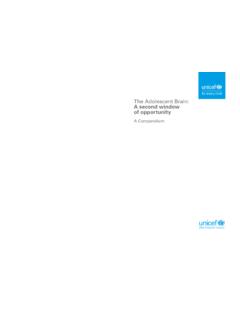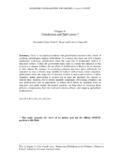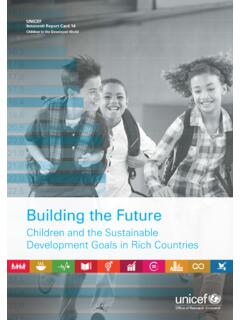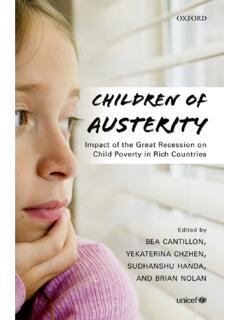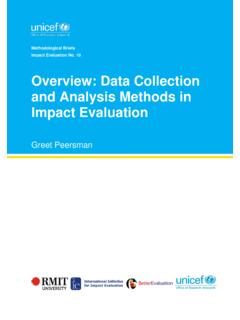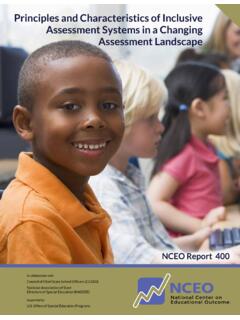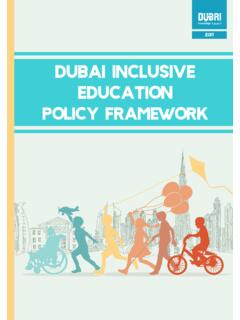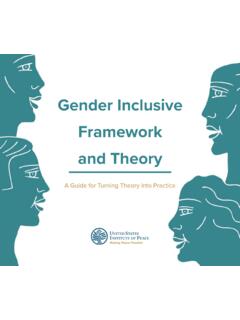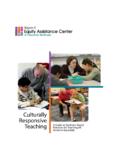Transcription of The Education of Children with Special Needs: Barriers and ...
1 United Nations Children 's FundInternational Child Development CentreFlorence - Italy1998 OCCASIONAL PAPERSE conomic and Social Policy SeriesEPS 67 The Education of Childrenwith Special Needs: Barriers and Opportunities in Central and Eastern EuropeMel Ainscow and Memmenasha Haile-GiorgisiInnocenti Occasional PapersECONOMIC AND SOCIAL POLICY SERIES no. 67 The Education of Children with Special Needs: Barriers and Opportunities in Central and Eastern EuropeMEL AINSCOW AND MEMMENASHA HAILE-GIORGIS*September 1998*Both of the University of Manchester, UKAcknowledgementsThe authors would like to thank John Micklewright and his colleagues at theUNICEF International Child Development Centre for their help and are also due to those who offered suggestions during the preparationof the paper.
2 They are grateful to Robert Zimmermann for the opinions expressed in this publicationare those of the authors and do not necessarilyreflect the policies or views of UNICEFC opyright UNICEF, 1998 Cover design: Bernard ChazinePrinted by: Arti Grafiche Ticci - Sovicille (Siena), ItalyISSN 1014-7837 Readers wishing to cite this document are asked to use the following form ofwords:Ainscow, Mel and Memmenasha Haile-Giorgis (1998), The Education ofChildren with Special Needs: Barriers and Opportunities in Central andEastern Europe . Innocenti Occasional Papers, Economic and Social PolicySeries, no. : UNICEF International Child Development SummaryThroughout the world Children who have disabilities and many others whoexperience difficulties in learning have traditionally been marginalized with-in or excluded from schools.
3 This paper examines the situation in countriesof Central and Eastern Europe, focusing in particular on developments thathave occurred over recent years and comparing these with overall interna-tional a result of the 1990 World Conference on Education for All: MeetingBasic Learning Needs, the challenge of exclusion from Education has been puton the political agenda in many countries. This has helped to focus attentionon a much broader range of Children who may be excluded from or marginal-ized within Education systems because of their apparent difficulties. Thesemay include those who are already enrolled in Education but for a variety ofreasons do not achieve adequately, those who are not enrolled in schools butwho could participate if schools were more flexible in their responses, and therelatively small group of Children with more severe impairments who mayhave a need for some form of additional this broad range of Children , all of whom may be seen as having spe-cial needs, the paper argues that it is essential to consider Special educationpolicies and practices in relation to overall educational arrangements withinany given national context.
4 This points immediately to a major difficulty fac-ing anybody wishing to summarize international trends in this field. That is tosay, when suggesting patterns , one must take care to engage with the waysin which Children come to be defined as being Special within particular places,since a child categorized as having Special needs in one country might not beso categorized in another. Consequently, it is necessary to examine the formsof Education provided for all Children within a given context, including a con-sideration of which Children are given the opportunity to participate in schoolsand who is analysis of the situation in the region is contrasted with overall inter-national trends. These trends include an emphasis on moves towards moreinclusive arrangements whereby schools are reformed in ways that extendtheir capacity to respond to diversity.
5 However it is important to recognizethat, throughout the world, such trends are the subject of considerable debate,not least as a result of arguments made by those who believe that the educa-tion of Children with Special needs can be provided more effectively throughseparate, specialized provision of various paper provides evidence of similar arguments within the region underconsideration. Unfortunately these may act as a barrier to improvementivExecutive Summaryefforts. Reviewing the information for selected countries in the region, thepaper illustrates some other Barriers to the improvement of educational oppor-tunities for Children with Special needs and to providing these opportunities ina way that allows the Children to learn alongside others in their local commu-nity schools.
6 It indicates how the depressed economic situation and the ensu-ing shortage of funds in much of the region prevent expenditure on initiativesthat would shift provision away from separate Special schools. This may beone reason why, in general, it is the richer countries that have been able tointroduce a degree of integration into their educational provision, although itis the poorer countries where the eventual improvements in practice and pos-sible cost-savings from effective integration efforts would be of greatest ben-efit. Meanwhile, a degree of institutional inertia, including that arising fromvested interests in the maintenance of the status quo, prevents reform in thisarea of educational provision.
7 Furthermore, the lack of wider developments ofeducation systems means that reforms in the Special needs field are even moredifficult. Finally, the inheritance of a dominant medical approach to assess-ment, categorization and intervention, influenced by the Soviet science of defectology , continues to be a major barrier to , the indications are that there is considerable debate in manyof the countries in Central and Eastern Europe as to how best to proceed inorder to provide effective schooling for all Children in these of this has been stimulated by contacts that have occurred with individ-uals and groups from countries outside the region. On the other hand, it is alsoimportant to recognize that those in the region have themselves generatedagendas for change as a result of internal review processes.
8 Within these dis-cussions very different positions exist, reflecting similar differences to thosethat exist throughout the developed world. In this sense the systems of Centraland Eastern Europe can be said to be in transition , much as the systems inmost other countries are around the the other hand, it is also true that certain traditions that are peculiar tothe region, particularly the emphasis on defectology , dominate the way pro-vision for Children with Special needs is conceptualized and organized. Thus,as reforms are proposed, it is inevitable that the overall global debates outlinedin the early sections of the paper should manifest themselves in a form thatseems likely to create further dispute.
9 All of this is likely to lead to some con-fusion amongst those who are unfamiliar with this wider debate. So, for exam-ple, parents, administrators and politicians may be faced, on the one hand,with highly regarded specialists who argue for a policy push to reform main-stream schooling in order to make it more inclusive , whilst, on the other hand,there may be equally eminent voices arguing for an extension of separate spe-vExecutive Summarycialized provision. And, of course, this seemingly contradictory advice has tobe evaluated within a context of reduced budgets for Education and an overallemphasis on raising standards in ways that can be seen to contribute to eco-nomic paper argues that those within these countries who wish to encouragemoves towards more inclusive practices need to be realistic in taking accountof the Barriers they face.
10 These are likely to take the form of negative attitudestowards certain groups within the community seen as being different, curric-ula and assessment policies that lack the flexibility to respond to pupil diver-sity, and the actions of those who, for a variety of reasons, have a vested inter-est in the maintenance of the status the other hand, the paper identifies traditions and experiences within theregion that provide important building blocks for further development. Forexample, the tradition of providing Education opportunities for all members ofthe community in many of these countries encourages an expectation that thisis a matter of right. In addition, the strong emphasis placed on the importanceof teacher Education is a significant starting point.


